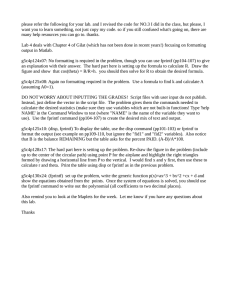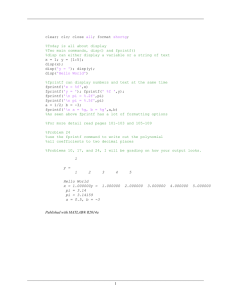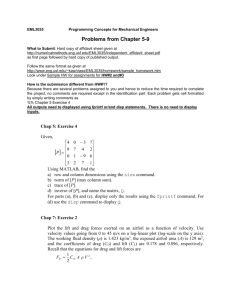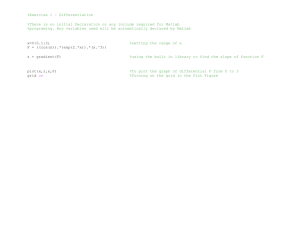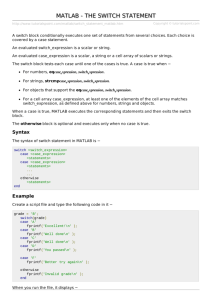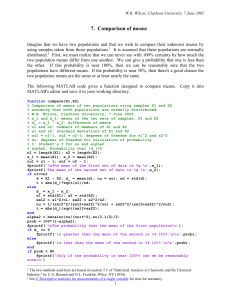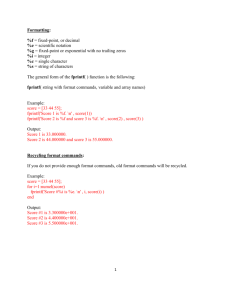ggge20247-sup-002c-supinfo2c
advertisement
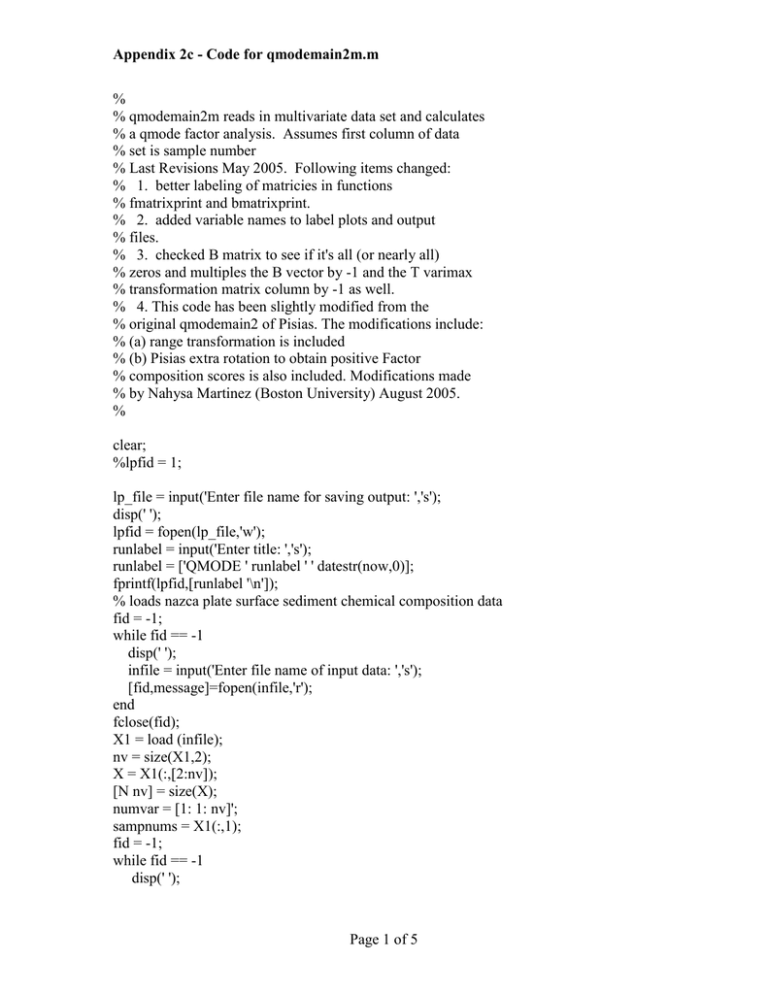
Appendix 2c - Code for qmodemain2m.m
%
% qmodemain2m reads in multivariate data set and calculates
% a qmode factor analysis. Assumes first column of data
% set is sample number
% Last Revisions May 2005. Following items changed:
% 1. better labeling of matricies in functions
% fmatrixprint and bmatrixprint.
% 2. added variable names to label plots and output
% files.
% 3. checked B matrix to see if it's all (or nearly all)
% zeros and multiples the B vector by -1 and the T varimax
% transformation matrix column by -1 as well.
% 4. This code has been slightly modified from the
% original qmodemain2 of Pisias. The modifications include:
% (a) range transformation is included
% (b) Pisias extra rotation to obtain positive Factor
% composition scores is also included. Modifications made
% by Nahysa Martinez (Boston University) August 2005.
%
clear;
%lpfid = 1;
lp_file = input('Enter file name for saving output: ','s');
disp(' ');
lpfid = fopen(lp_file,'w');
runlabel = input('Enter title: ','s');
runlabel = ['QMODE ' runlabel ' ' datestr(now,0)];
fprintf(lpfid,[runlabel '\n']);
% loads nazca plate surface sediment chemical composition data
fid = -1;
while fid == -1
disp(' ');
infile = input('Enter file name of input data: ','s');
[fid,message]=fopen(infile,'r');
end
fclose(fid);
X1 = load (infile);
nv = size(X1,2);
X = X1(:,[2:nv]);
[N nv] = size(X);
numvar = [1: 1: nv]';
sampnums = X1(:,1);
fid = -1;
while fid == -1
disp(' ');
Page 1 of 5
Appendix 2c - Code for qmodemain2m.m
labelfile = input('Enter file name with variable labels: ','s');
[fid,message]=fopen(labelfile,'r');
end
for i = 1: nv
variable(i).names = fscanf(fid,'%s',1);
end
%variable(10).names ='Ba';
% calculate means and variances and output
%X = X ./ 1000.;
xmean = mean(X)';
xvar = var(X)';
format = '%7i %20.4f %20.4f \n';
fprintf(lpfid,'Var. Num. Variable Name Means
Variance \n');
for j = 1: nv
Sout = sprintf('%7i',numvar(j));
Sout = [Sout ' ',sprintf('
%s',variable(j).names)];
Sout = [Sout ' ',sprintf('%20.4f %20.4f \n',xmean(j),xvar(j))];
fprintf(lpfid,'%s',Sout);
end
% get input parameters If needed, scale data
%alpha = 100;
disp(' ');
alpha = input('alpha level, e.g. 95: ');
disp(' ');
disp('Enter 0 for No Pretreatment, 1 for Constant Mean,');
mode = input( '2 for percent max,3 for range, and 4 for log: ');
if mode > 4 | mode < 0
mode = 0
end
vectorlengths = sqrt(diag(X * X'));
% transform data
[x, Xmin, Xmax, Ks, Kbar, constant] = transform2m(X,mode,lpfid);
% data now in and scaled to constant mean of 100 if needed.
% go to qmode subroutine
[U,B,F,scF,Lambda,Pervar,Cumvar,count] = qmode2(x,alpha);
Lambda = diag(Lambda);
% factor analysis completed. Results are in B and F.
% output initial results
fprintf(lpfid,'\n');
Page 2 of 5
Appendix 2c - Code for qmodemain2m.m
nout = size(F,2);
nvcount =[1: 1:count];
fprintf(lpfid,'
Eigen Values Per. Infor. Accumulative Information \n');
fprintf(lpfid,'%10i %10.4f %10.4f %10.4f \n',[nvcount' Lambda(1:count)
Pervar(1:count) Cumvar(1:count)]');
fprintf(lpfid,'\n');
fmatrixprint(lpfid,'Principal Factor Scores Matrix',F,variable);
%output completed
% get number of factors wanted in analysis
message = ['Count = ', num2str(count)];
disp(message);
Pervar(1:count)
count = input('Enter NO. of Factors to keep: ');
B = B(:,1:count);
comm = diag(B*B');
Info = diag(B'*B);
PerInfo = Info * 100/N;
CumInfo = cumsum(PerInfo);
% now ouput factor loadings
bmatrixprint(lpfid,'Principal Factor Loadings Matrix', [sampnums comm B]);
format = '';
for j = 1: count
format = [format,'%8.4f '];
end
format = [format,'\n'];
fprintf(lpfid,['Percent Information
' format],[PerInfo(1:count)']);
fprintf(lpfid,['Cumulative Info.
' format],[CumInfo(1:count)']);
fprintf(lpfid,'\n');
% now output results.
% Now we have printed the B - Loadings matrix now
% do factor rotations using varimax
[CFS, scalefactors] = compositionscores2m(F, Kbar, Xmax, Xmin);
scalefactors = scalefactors(1:count);
CFS = CFS(:, 1:count);
fmatrixprint(lpfid,'Factor Composition Scores ',CFS,variable);
goodness = nodosgoodns(X,B,CFS,scalefactors,Xmax,Xmin,Ks,
Kbar,vectorlengths,lpfid,variable);
[B, T] = varimax(count,B);
comm = diag(B*B');
Info = diag(B'*B);
Page 3 of 5
Appendix 2c - Code for qmodemain2m.m
PerInfo = Info * 100/N;
CumInfo = cumsum(PerInfo);
% need to see if we need to multiply a factor by -1 because B's are all <0
% We can then adjust the T matrix (we might want this later) so that the L
% matrix is correct sign.
for j = 1: count
positives = find(B(:,j)>0);
if size(positives,1) < N/2
B(:,j) = -B(:,j);
T(:,j) = -T(:,j);
end
end
F = F(:,1:count);
L = F*T;
bmatrixprint(lpfid,'Varimax Factor Loadings Matrix',[sampnums comm B ]);
fprintf(lpfid,['Percent Information
' format],[PerInfo(1:count)']);
fprintf(lpfid,['Cumulative Info.
' format],[CumInfo(1:count)']);
fprintf(lpfid,'\n');
% calculate Varimax Factor Scores using T matrix and output
fmatrixprint(lpfid,'VARIMAX Factor Scores Matrix ',L,variable);
% Scale the factor scores.
scale = ones(nv,1) * (ones(count,1) .* sqrt(nv))';
LS = L .* scale;
fmatrixprint(lpfid,'VARIMAX Scaled Factor Scores Matrix ',LS,variable);
[CFS, scalefactors] = compositionscores2m(L,Kbar,Xmax,Xmin);
fmatrixprint(lpfid,'VARIMAX Factor Composition Scores ',CFS,variable);
% Do the extra rotation to get scores in a positive space using Leinen &
% Pisias, (1984).
[ERCS]=positiverot(X,CFS);
fmatrixprint(lpfid,'Final Factor Composition Scores ',ERCS,variable);
fclose(lpfid);
% plot data
xtic = [];
for i = 1: nv
xtic = [xtic;variable(i).names];
end
Page 4 of 5
Appendix 2c - Code for qmodemain2m.m
figure (1)
xcount = [1: 1: nv]';
for i = 1:count
subplot(2,4,i)
bar(xcount,(L(:,i)),'r')
h = gca;
%get(h)
set(h,'XTick',numvar);
set(h,'XLim',[0 numvar(nv)]);
set(h,'XTickLabel',xtic);
if i == 1 | i == 5
ylabel('Scores')
else
ylabel('')
end
h =title(['Factor ',num2str(i)]);
set (h,'FontSize',12);
end
Page 5 of 5
